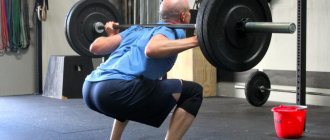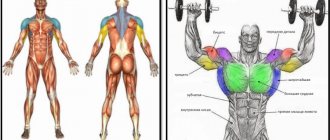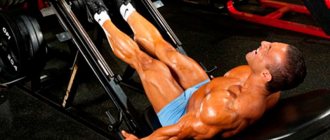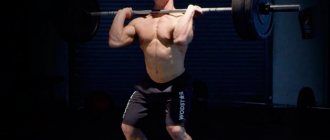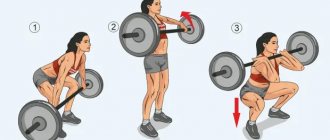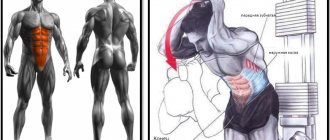December 18, 2022 Admin Home page » Lat + upper back
Learn how to build powerful traps with a farmer's walk. Benefits and contraindications. Execution technique. Training complexes.
Everyone knows the golden three exercises - “squats, bench press and deadlift”, which are actively used in both bodybuilding and powerlifting. At the same time, many actively use shrugs to pump up the upper back muscles, but at the same time they forget the farmer’s walk for the exercise, and some remember, but simply “forget” and in vain.
Below we will talk in detail about all the nuances of performing this old-forgotten but effective exercise.
Farmer's walk
Today we will tell you about the CrossFit exercise Farmer's walk.
The benefits and harms of exercise
What can be said about the benefits of the farmer's walk exercise? The muscles of the legs and abs work in a balanced manner, the load is evenly distributed between the muscles of the abs, thighs, legs and feet. At the same time, all of the listed muscle groups work in a single “bundle”, mutually complementing and reinforcing each other. After a farmer's walk, an ordinary walk will seem indescribably light to you - you will no longer feel the weight of your own body by at least half.
But where there are pros, there are also cons. The downside is the risk of injury in the lumbar spine. During walking, the articulation between the pelvis and the spine actively works, and rotational movement occurs in the vertebrae of the lumbar spine. This type of mutual movement of the vertebrae is not very useful and is limited by the powerful ligamentous apparatus of the spine. By picking up weights, we repeatedly increase the load on this ligamentous apparatus and increase the risk of injury. The solution is to avoid the farmer's walk during the first years of active CrossFit training until you acquire a strong core, or use a weightlifting belt. The first option is preferable, since the belt will in any case remove some of the load from the abdominal muscles, especially the obliques, and the extensor spinae.
Exercise technique
There are several variations of the farmer's walk exercise, namely with dumbbells, kettlebells or other weight options.
With dumbbells
We take weights from the floor.
- The lower back is arched and fixed;
- The shoulder blades are retracted;
- Hands at your sides.
Without bending your lower back, bend your knees and hip joints and take dumbbells in your hands. When using dumbbells of significant weight, you can use bands - this will allow you to cover a greater distance, but will take the load off the finger flexor muscles. Another option for “lightening” the hand is a closed “overlapping” grip, when the thumb rests on the bar of the dumbbell, the rest covers it and firmly fixes it to the apparatus.
And so, the weight is in the hands, the shoulder blades are brought together, the back is straight. Knees slightly bent, feet shoulder-width apart. We take the first step; the heel is placed on an imaginary line running from the toe. This way the steps are short. You are unlikely to cover even a short distance too quickly, thereby ensuring sufficient time for the muscles to be under load. A short step is also taken to reduce the range of motion in the lumbar vertebrae and hip joint, the most vulnerable to compression loads. Throughout the farmer’s walk, the body is kept level, the shoulders are moved slightly forward, the trapezius muscle seems to be spread across the upper shoulder girdle.
In the technique described above, the main load falls on the muscles of the lower limb girdle. The back, trapezius and arms perform only static work, with the main load falling on the finger flexors. In order to more seriously load the muscles of the upper shoulder girdle with the “farmer’s walk,” there are the following exercise options.
With weights
Initial position:
- Feet shoulder width apart;
- The back is straight;
- There is a deflection in the lower back;
- The arms are bent at the elbows, the wrists are tucked under the arms of the weights;
- The weights themselves rest on the elbow bends;
- The elbows are pressed to the chest, brought forward.
A more difficult modification of the farmer’s walk is this option: the starting position is the same, but the weights are on the shoulders, held by the fingers of the hands, the arms are bent at the elbows, the elbows are spread to the sides.
Farmer's walk up the stairs
To increase the overall intensity of the exercise, as well as increase the load on the leg and abdominal muscles, the farmer's walk can be performed on stairs. The weight is held in straightened arms, arms along the body, elbows straightened. The back is straight, the shoulders are slightly rolled forward, the upper portion of the trapezius is tense. We take a step up one step, transfer the body weight to the supporting leg, place the working leg on the upper step, and with the combined force of the quadriceps and biceps of the thigh, we extend the leg at the knee and hip joint. We place both legs on one step, and take the next step with the supporting leg.
You can take each step to the next step, but this will limit the time the muscles are under load and create greater mobility in the lumbosacral joint.
Complexes
| Weston | Complete 5 rounds against the clock
|
| Lavier | Complete 5 rounds against the clock
|
| Dobogay | 8 rounds against the clock
|
Rate the material Source: cross.expert
This is interesting: Dumbbell swings to the sides: an exercise for developing the shoulder girdle, technique and recommendations for performing dumbbell swings to the sides
Instructions for use
There are four variations of farmer's walks in total, and there are about seven basic movements.
Weight between legs
Holding a weight between your legs places special emphasis on the gluteal muscles.
Duck walk
Take the weights in your hands, bend over a little and, placing them between your legs with your arms down, stomp forward. Keep your legs slightly bent, do not round your lower back. If you don't have weights, hold a large dumbbell with both hands by the disc, positioning it vertically. The weight should be at knee level, not higher.
Important: don't look down! If you keep your eyes down while doing exercises that develop your balance, you will ruin everything. A downward gaze gives you a false sense of stability and increases stress on your lower back and knees, shifting your center of gravity forward.
So look strictly in front of you at some distant stationary object
So look strictly in front of you at some distant stationary object.
Side weight
This way you can carry the heaviest shells. That’s why these exercises give unrealistic strength gains.
Farmer's walk
Pick up dumbbells, kettlebells, or even two barbells and move forward. Keep your abdominal muscles tense and bend your knees slightly. If the dumbbells in your gym are light, use a trap bar with barbell discs.
Walking with a suitcase
Take a heavy dumbbell in one hand and, trying to keep your body upright, walk forward. Walk an equal distance for your right and left hands.
Weight in front of you
The advantage of this variation is the additional load on the biceps and the entire posterior chain of muscles.
Zercher Walk
Place the barbell on your elbows and, holding the barbell as close to you as possible, carefully move forward. If you feel uncomfortable holding the barbell, wrap a towel around the bar.
Bear hug
Hug and hold the sandbag to you in an upright position. Instead, you can take a heavy barbell disc or just a stone. As a last resort, hold the dumbbell vertically at your chest under the upper disk - just like when doing squats with a dumbbell.
Weight above you
Holding a weight overhead targets the entire core and improves shoulder stability.
Army walk
Take a sandbag or barbell and lift it above the top of your head - just like doing a standing press. Keep your arms straight, legs slightly bent, and your lower back straight. You can also hold two dumbbells above you.
Inverted kettlebell
Take a weight and turn it upside down. Keep your forearm vertical and keep the angle between your shoulder and forearm straight.
How to choose a load?
How many pounds you carry and how far you carry may determine what exactly you develop with this type of training. Theoretically, “walking” can develop both strength and hypertrophy with endurance. Use these simple formulas to vary your own workouts:
Projectile weight*Distance, m
| Force | 100% | 15 |
| Hypertrophy | 75% | 45 |
| Endurance | 50% | 90 |
*% of your own weight
Farmer's Walk. We study all the subtleties and secrets
My respect to the entire honest ABC Bodybuilding company! The calendar says Wednesday, 3 , which means that today we will have a technical note, and in it we will talk about the farmer’s walk exercise.
After reading, you will learn everything about the muscle atlas, the advantages and technique of performing the exercise, we will also find out the degree of its effectiveness and the advisability of including it in your training program.
So, seatdown please, we begin.
Farmer's Walk. What, why and why?
Despite the unusual name, I am sure that many people are familiar with the farmer’s walk, especially women. Why is it closest to them? Everything is very simple, precisely because ladies are responsible for the food security of their family and go shopping more often. So, our worker entered the store with empty bags and within a few minutes came out, loaded with string bags, with various products in both hands. This picture can be seen very often - a woman walks with two heavy bags, and it is similar to the exercise of a farmer's walk. We’ll find out what further.
Note:
For better assimilation of the material, all further narration will be divided into subchapters.
Muscle atlas
The Farmer's Walk is a compound exercise, i.e. Many muscle groups take part in the work, and the effect on the body is complex.
The muscle ensemble of the exercise includes the following forces and units:
- dynamic: hip/knee – extension, ankle – plantar flexion;
- static: spine (thoracic/lumbar) – extension, scapula/clavicle – lifting up, fingers – flexion.
A complete muscle atlas looks like this:
Advantages
By performing the farmer's walk exercise, you can expect to receive the following benefits:
- development of athlete's endurance;
- general development of leg muscles, both strength and mass;
- developing core muscle strength and creating a natural corset that supports the spine;
- enlargement of the deltoid muscles of the upper shoulder girdle;
- development of grip strength;
- growth hormone stimulation;
- the ability to overcome a training plateau;
- increased calorie consumption;
- development of coordination;
- the ability to perform at home without going to the gym.
Execution technique
The exercise is not difficult to perform, but it has its own characteristics. The step-by-step execution technique is as follows.
Step #0.
The classic apparatus for this exercise is a barbell with handles, but dumbbells/weights can also be used. Place both projectiles on the floor and stand between them. Tighten your abs, keeping your back straight, squat down and grab the handles of the barbells with your hands. Push yourself upward with your heels and lock in with your gaze directed forward. This is your starting position.
Step #1.
Take short, quick steps and move straight ahead with the barbells in your hands, while remembering to breathe. Move 25-50 meters, place the shells, turn around and do the same in the opposite direction. Perform 5-10 of these “walks” in one direction without resting between them.
In the picture version, all this disgrace looks like this.
Variations
In addition to the classic version of the farmer's walk, there are several variations of the exercise, in particular:
- with dumbbells;
- with weights.
Secrets and subtleties
To get the most out of the exercise, follow these guidelines:
- lower yourself down behind the apparatus as you usually squat, and not take it from the top position with a rounded back;
- select the weight for yourself based on the formula = body weight / 4 , for example, for an athlete of 60 kg, the weight of each dumbbell should be 15 kg;
- when walking, do not take long steps, but mince in medium ones;
- while walking, do not lower your head down or round your shoulders;
- use a weightlifting belt when lifting serious weights;
- if the exercise is difficult, start with 2-4 “walks” of 20-30 seconds each and gradually increase the weight of the apparatus, time and number of sets.
We're done with the theoretical side, now let's look at some practical points.
Is the Farmer's Walk an effective exercise?
As evidenced by numerous data on EMG muscle activity, the farmer's walk is one of the best complex exercises, evenly loading a large number of muscle groups. Such a cumulative load allows you to achieve not only an increase in the strength and endurance of the athlete, but also burn more calories than in conventional (even multi-component) exercises.
The farmer's walk is a competitive exercise in the discipline of strongman, but can also be used in bodybuilding to increase the strength and endurance performance of an athlete.
Is the farmer's walk a safe exercise?
Fifty-fifty...Ie. If an athlete initially has scoliosis and a weak back, then he should not perform the exercise until a sufficient muscular frame of this group has been formed. In other words, you need to first build a strong frame and only then move on to the farmer's walk.
Experienced athletes with a built base should remember that if the weight is incorrectly selected (too much), it will tilt you forward, causing you to round your shoulders/back. Walking in this technique risks causing injury and dislocating your shoulder joints.
Conclusion: working with the exercise is indicated only after laying the foundation for the main muscle groups and with the correct choice of weight of the projectile.
Actually, we’re done with the substantive part, it’s time to move on to...
Afterword
Today we were introduced to the farmer's walk exercise. Have you used it before this article? Most likely no. Will you use it after reading it? Most likely no
